Furthermore, each circuit (grid 2-3) provides a great variety of movement and technical emphases – while some drills feature very high-repetition ball contact, with a focus on fast footwork and technical coordination in tight spaces, others require a high level of collective technical cohesion between players. The drills also vary with regard to complexity, timing of movement, tempo and acceleration, as well as passing ranges (10-30 metres).
Set-up for all drills
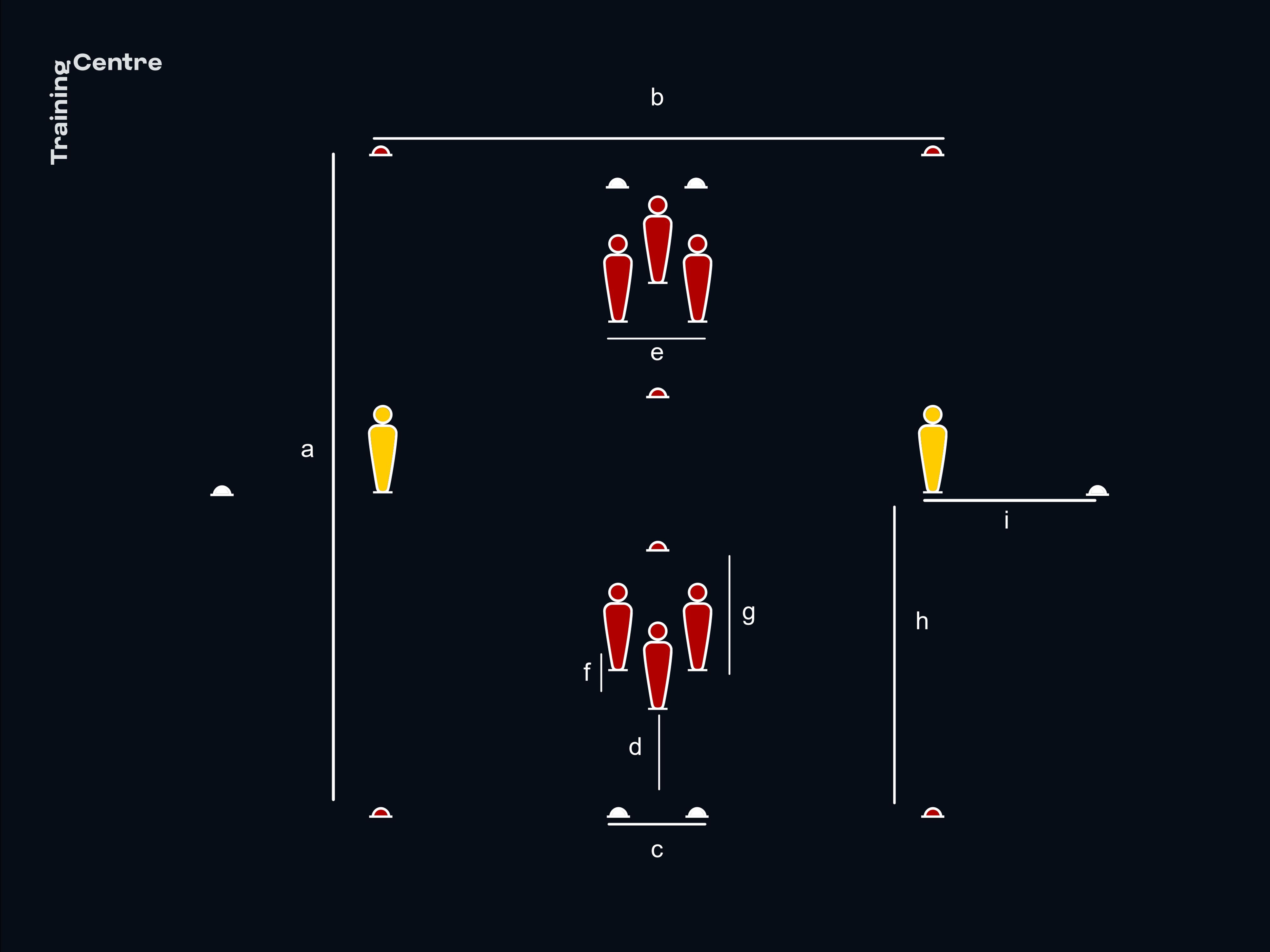
Organisation
- Lay out a 20x32m grid marked with flat white cones (a: 32m and b: 20m).
- Place a 2m-wide gate comprising 2 flat white cones (c) in the middle of each of the 20m lines.
- Place a red mannequin inside the grid, 6m from each of the flat white cone gates (d).
- Create two 3m-wide red mannequin gates (e) a further 2m inside from the single red mannequins (f).
- Place a flat red cone 6m (g) from each of the 2 red mannequin gates on the inside of the grid.
- At the midpoint of each of the 32m lines (a), place a single yellow mannequin (h).
- Complete the set-up by placing a single white cone 5m from each of the two yellow mannequins on the outside of the grid (i).
- If no mannequins are available, cones/discs may be used instead.
Drill duration
- 5-7 players: 3 minutes after a period in which players are given the time to familiarise themselves with the scenario.
Approximate workload intensity
Fitness is a key element in these drills, which are to be completed at a high tempo.
- 5-6 players (optimum number): medium intensity.
Coaching points that apply to all drills
- Allow players 30 seconds to find their tempo and familiarise themselves with the scenario, before gradually raising the intensity demands.
- Devote a period of time (minimum of 1 minute) during each drill to intensity, technical skills and the development of awareness habits.
- Encourage players to move quickly between positions.
This set-up can be adapted to involve a full squad comprising 20 players or more. Where this is the case, 2 circuits are required, with 2 balls and 10-12 players involved in each circuit. As an alternative, set up 2 circuits with 1 ball in each circuit and 5-7 players in each half of a circuit.
Drill 1: Fast footwork and technical coordination to move quickly into space
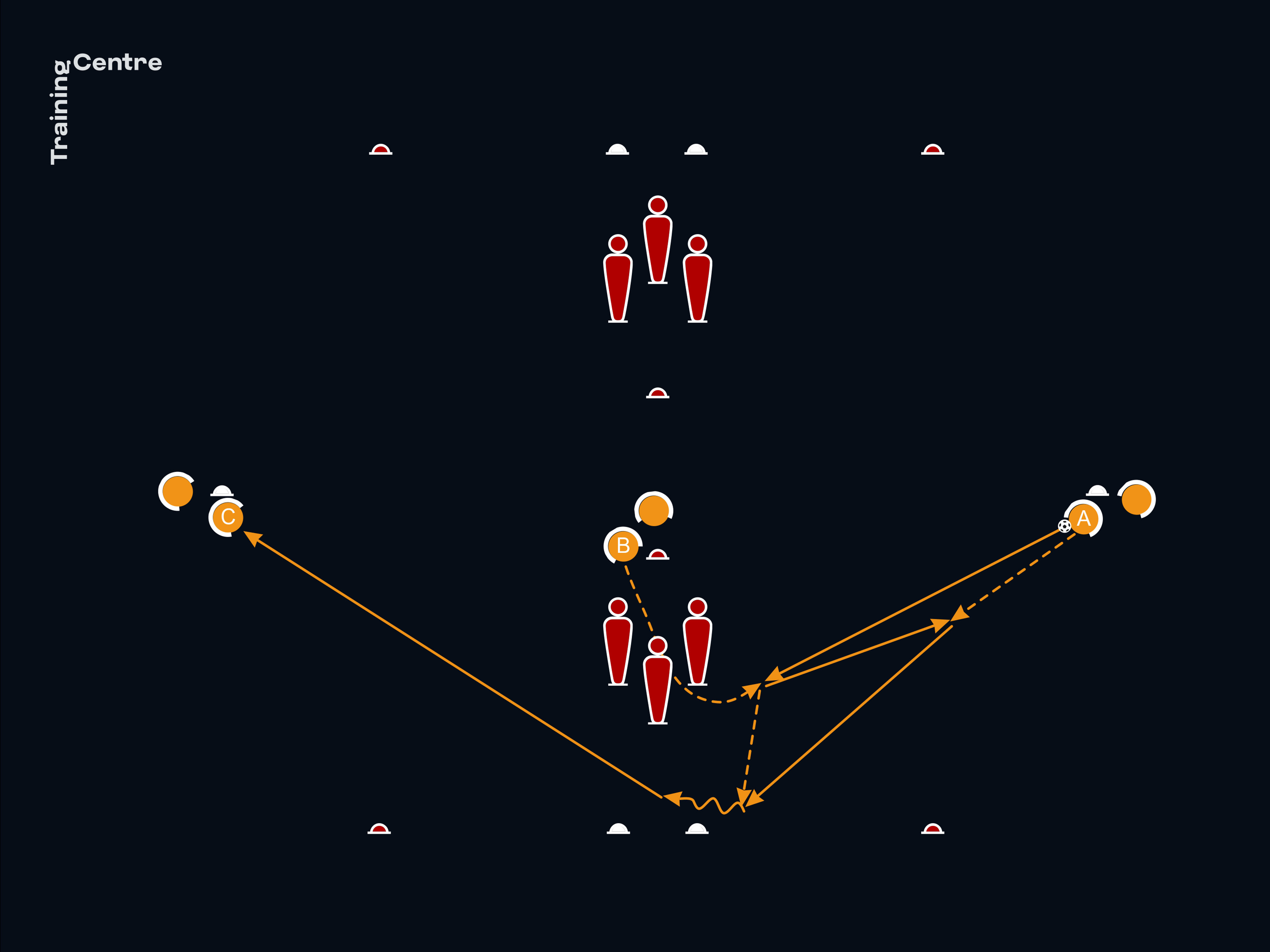
-
A plays a short diagonal pass to B, who leaves their starting position to dart through the mannequin gate on the half-turn.
-
B plays a return pass before dropping back and moving away with quick feet to receive a second pass from A.
-
B then moves the ball on the first touch and plays a diagonal pass to C at the opposite starting position.
-
C then starts the next sequence on the opposite side of the grid.
-
Every player follows their final pass so as to ensure rotation.
-
A moves to B.
-
B moves to C.
-
Place the emphasis on players' fast footwork and technical coordination while they are turning to face play, dropping back and turning to switch play upon receiving the ball from one side to play out to the other.
-
Players should play with their heads up and scan the area they are receiving the pass from and the intended destination of their own pass.
-
To promote complete technical balance, the directions should be inverted in the following sequence so as to encourage efficiency of movement and two-footedness.
-
B should accelerate through the mannequin gate on the half-turn while also keeping an eye on A, before playing the return pass and scanning across to C.
-
On receiving the ball from A, B should move it quickly into their path and lift their head up before playing the diagonal pass to C.
-
B should try to play the final diagonal pass to the left using the left foot. The opposite applies for the final diagonal pass to the right.
Drill 2: Multi-movement, fast footwork and coordination
-
There are a total of three movement rotations for the main player, B. The first rotation follows the same pattern as drill 1, while two further rotations are then added, before players change positions.
-
A starts the sequence with a short diagonal pass (pass 1) to B, who leaves their starting position to move quickly through the mannequin gate on the half-turn.
-
B plays a return pass (2) before dropping back and moving away with quick feet to receive a second pass from A (3).
-
B then moves the ball on the first touch and plays a diagonal pass to C (4) at the opposite starting position.
-
B moves quickly forward to the outside of the mannequin gate to receive a return pass from C (5) and plays a short pass forward to D (6) around the outside of the gate, before dropping back quickly to meet D's return pass (7), which is to be played into the space between the gate’s near mannequin and the sole middle red mannequin.
-
B then moves the ball past the middle mannequin and plays a diagonal pass to A (8).
-
B again moves back away quickly on the half-turn to receive another return pass from A (9), moves the ball into their own path and plays a diagonal pass to C on the other side (10) to finish the sequence.
-
C then starts the next sequence on the opposite side of the grid.
-
D moves to B.
-
B moves to C.
-
C moves to D.
-
Encourage the players to move quickly between the positions after the last rotation.
-
As with drill 1, drill 2 is all about the individual player, with a focus on fast footwork, movement quality and technical balance while facing the play, but now with a higher volume of ball contact.
-
This drill encourages technical balance as it requires players to use their left and right feet in equal measure.
-
B should use their right foot for the diagonal pass to C. The opposite applies when playing the diagonal pass left to A.
-
During the second rotation, B should try to move the ball from one foot to the other beyond the middle mannequin, getting their head up before playing the diagonal pass to A.
-
During the third rotation, B should try to move the ball and play it out to A with the same foot, i.e. right foot to play to the right, left foot to play to the left.
-
B should always scan towards the players on the opposite side before passing.
Drill 3: With back to play, fast footwork to create space, turned ready to play forward
-
A plays a forward pass wide of the 3 mannequins and diagonally in front of B.
-
B starts in front of the single mannequin and moves their feet quickly and diagonally on the half-turn to receive the ball wide of the gate, before darting across the gate to play a diagonal pass to C.
-
C plays a diagonal pass to A.
-
The next player in position A starts the next sequence, which is to be played in the opposite direction.
-
A plays a short forward pass to B, who moves clear to one side of the single mannequin and plays a one-touch return pass to A.
-
B needs to show even faster footwork to dart through the space between the mannequin gate and the single mannequin and receive A’s short diagonal pass on the half-turn, wide of the mannequins.
-
B then plays a diagonal pass to C.
-
C plays a diagonal pass to A.
-
The next player in position A starts the next sequence, which is to be played in the opposite direction.
-
Every player follows their pass so as to ensure rotation.
-
A moves to B.
-
B moves to C.
-
C moves to A.
-
Players should move quickly between positions. Place the emphasis on the quality of each pass into the path of the next player in the sequence.
-
Players should play with their heads up and scan the area they are receiving the pass from and the intended destination of their own pass.
-
With an odd number of players, this drill forces players to use both feet. With an even number of players, the coach should switch things up mid-exercise to ensure all players use both feet.
-
With the second sequence, A should start behind the small cone gate and step forward to meet C's pass and try to play it first-time into B's path, speeding up the movement.
-
Upon receiving the ball, B should move it quickly into their path and get their head up to scan in the direction of their intended pass to C.
-
B should play the diagonal pass to the left with the right foot. The opposite applies for the diagonal pass to the right.
-
To reinforce good footballing habits, B should scan towards C before receiving the ball.
-
B should show quick feet to create space and be positioned to move the ball into their intended path with the first touch. If possible, they could even be ready to play a first-time pass to C.
Drill 4: Meeting the ball on the move, changing direction and receiving the return pass
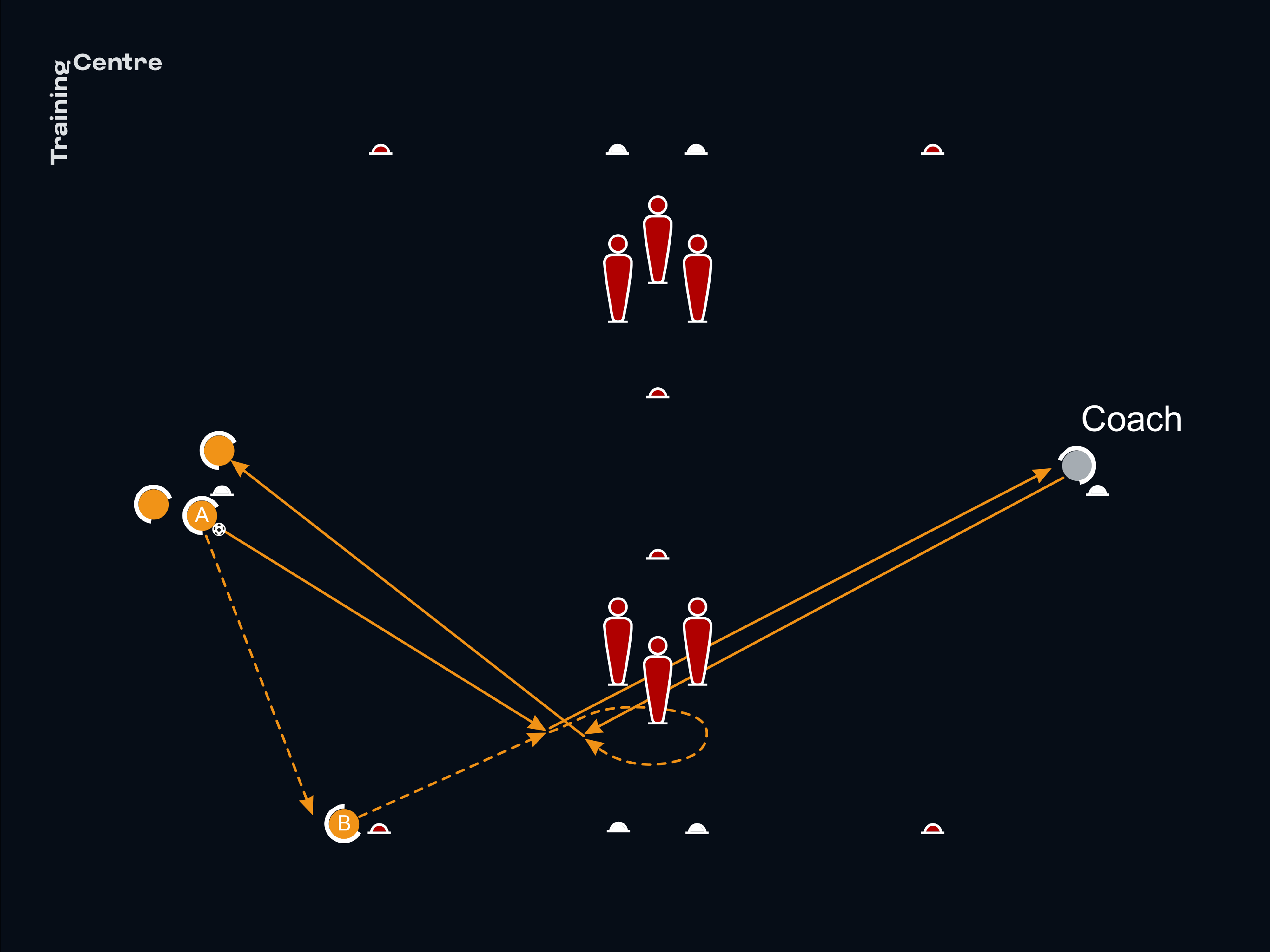
-
A plays a short diagonal pass into B's path and moves to B's starting position.
-
B starts from the wide position and times their movement to meet the ball, then plays a diagonal pass into the space between the mannequin gate to the coach/server.
-
B runs through the space between the mannequin gate and the middle mannequin, turns and times a run to receive the coach's/server's return pass in the opposite direction beyond the gate.
-
B finishes the sequence by playing a diagonal pass to the next player in the starting position.
-
The next player in position A then starts a new sequence on the opposite side.
-
Every player follows their pass so as to ensure rotation.
-
A moves to B.
-
B moves to A.
-
Place the emphasis on the timing of the movement to meet the ball with a first-time lay-off and fast footwork to change direction and move wide/spin around the mannequin to receive the return pass.
-
Players should play with their heads up and scan the area they are receiving the pass from and the intended destination of their own pass.
-
With an odd number of players, this drill forces players to use both feet. With an even number of players, the coach should switch things up mid-exercise to ensure all players use both feet.
-
For technical balance, A should try to play the diagonal pass to B to the left with the left foot. The opposite applies for the diagonal pass to the right.
-
During the left-side rotation, B should try to lay a first-touch diagonal pass to the coach/server to the right using the right foot and a first-touch diagonal pass, again right-footed, to the left of the starting position. The opposite applies for the right-side rotation.
Drill 5: Moving quickly into space followed by a give-and-go in behind and a diagonal pass
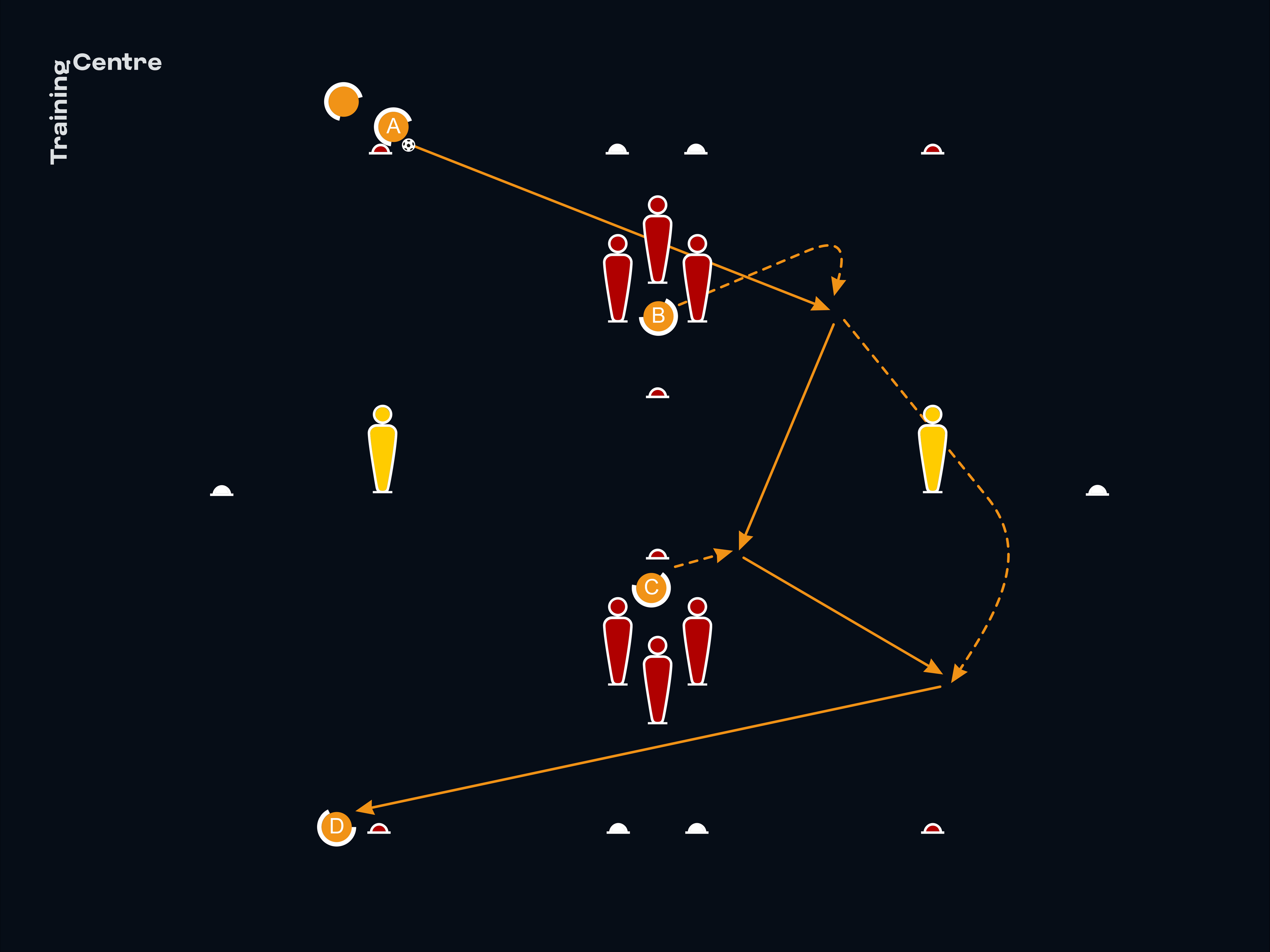
-
A plays a diagonal pass into the path of B.
-
B quickly moves through the gap between the mannequin gate and the middle mannequin that is closest to A, then laterally away from the mannequin on the half-turn forward to receive A's pass.
-
B moves the ball forward on the first touch to play an infield forward give-and-go pass to C.
-
B makes a strong curved run beyond the outer yellow mannequin to meet the return pass and finishes the sequence by playing a diagonal pass to D at the opposite-end starting position.
-
D then starts the next sequence in the opposite direction.
-
A moves to B.
-
B moves to D.
-
C stays in position to become the main focus player for the next sequence.
-
Place the emphasis on B playing forward quickly, on the coordination between the unit of three players and on passing quality, which is key to making the interplay seamless.
-
Players should play with their heads up and scan the area they are receiving the pass from and the intended destination of their own pass.
-
This drill encourages technical balance as it requires players to use their left and right feet in equal measure.
-
For the left-side rotation, B should try to play both passes (the infield pass to C and the longer diagonal pass to the new starting position) to the right of the recipient and using the left foot. The opposite applies for the right-side rotation.
-
To reinforce good footballing habits, B should have a quick scan towards C before receiving A's pass.
Drill 6: Stepping in to play a diagonal pass into a curved run in behind
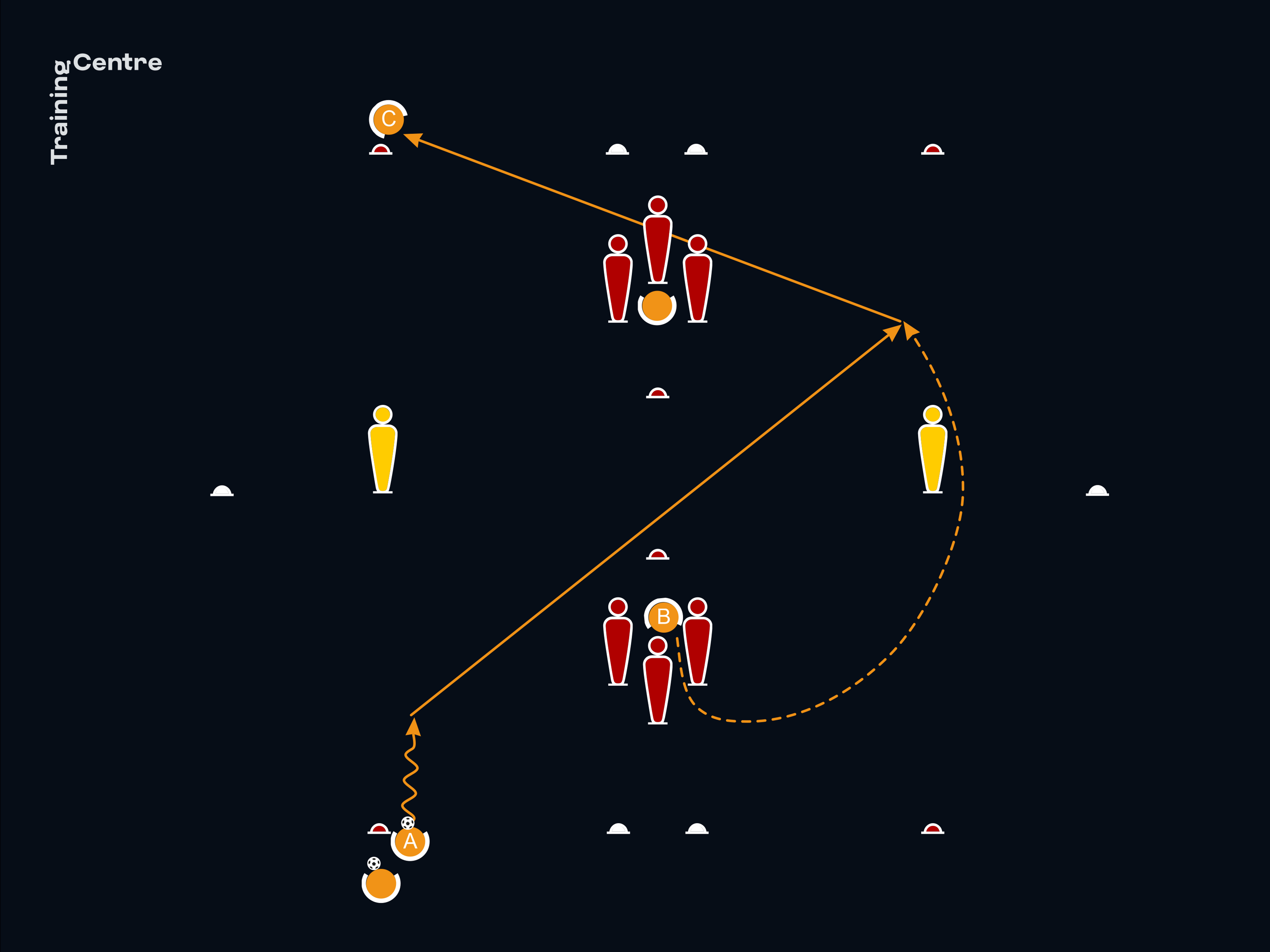
-
A moves the ball forward on the first touch and then plays a diagonal pass in behind into the path of B.
-
B runs through the gap between the mannequin gate and the middle mannequin farthest from A to then make an accelerating curved run around the outside of the yellow wide mannequin, timed to the movement and first touch of A.
-
Upon receiving A's pass, B should play a firmly weighted (and, if possible, first-time) diagonal pass to C at the opposite starting position.
-
C then starts the next sequence in the opposite direction.
-
Every player follows their pass so as to ensure rotation.
-
A moves to B.
-
B moves to C.
-
Place the emphasis on the quality of A's first touch forward and of the pass into B's path: the better they are, the higher the tempo will be and the more efficient the drill.
-
Players should play with their heads up and scan the area they are receiving the pass from and the intended destination of their own pass.
-
This drill encourages technical balance as it requires players to use their left and right feet in equal measure.
-
When playing the pass out wide to the left, A should look to shift the ball into space with a left-footed first touch, before playing a left-footed pass with their second touch. The opposite applies when the drill is performed on the right side.
-
When playing the diagonal pass across to C to the left, B should try to play it with the right foot. The opposite applies for the diagonal pass to the right.
-
To reinforce good footballing habits, B should scan over their shoulder to A while moving away on the half-turn to assess the timing of A's pass.
Drill 7: Moving away on the half-turn without the ball followed by instant acceleration with it

-
A plays a diagonal pass into the path of B.
-
B quickly moves their feet backwards to the position wide of the mannequin gate and, on the half-turn forward, accelerates with the ball towards the circuit’s midpoint before playing a diagonal pass to C at the opposite-end starting position.
-
C then starts the next sequence in the opposite direction.
-
Every player follows their pass so as to ensure rotation.
-
A moves to B.
-
B moves to C.
-
Place the emphasis on B's fast footwork and transition from moving away on the half-turn without the ball to instant forward acceleration with the ball.
-
Players should play with their heads up and scan the area they are receiving the pass from and the intended destination of their own pass.
-
This drill encourages technical balance as it requires players to use their left and right feet in equal measure.
-
A should try to play a well-weighted pass not too far in front of B.
-
During the right-to-left- diagonal acceleration, B should allow the ball to run to the right foot before accelerating forward with it. The opposite applies for the left-to-right acceleration.
-
To reinforce good footballing habits, B should scan towards the area of their intended movement and get their head up before making the diagonal pass.
Drill 8: Turning, moving inside and switching play with a cross-field ball in behind

-
A plays a diagonal ball towards B at the yellow outside mannequin.
-
B steps forward to move the ball infield across the mannequin, before playing a cross-field pass into C's path.
-
C, at the opposite yellow mannequin, makes a little forward run to meet B's pass and plays a diagonal pass to D at the opposite starting point.
-
D then starts the next sequence in the opposite direction.
-
Every player follows their pass so as to ensure rotation.
-
A moves to B.
-
B moves to C.
-
C moves to D.
-
Place the emphasis on the quality of B's first touch infield into their own path, teeing up the pass to C.
-
Players should play with their heads up and scan the area they are receiving the pass from and the intended destination of their own pass.
-
Special emphasis should be placed on collective understanding and the quality of the movement, timing and passing between A, B and C.
-
This drill encourages technical balance as it requires players to use their left and right feet in equal measure.
-
To reinforce good footballing habits, A/D should scan towards C/B before receiving the ball, then move it into their path with their first touch, lifting their head before passing it on.
-
When playing the diagonal pass to the right, A should try to move the ball on the first touch with the right foot and play a right-footed pass. The opposite applies for the diagonal pass to the left.
-
During the left-to-right rotation, B should try to move the ball infield on the first touch to set up a right-footed pass to C. The opposite applies for the right-to-left rotation (a left-footed pass).
-
C should keep their eyes on the ball, timing their run from behind the yellow outside mannequin to meet B's pass.
-
When playing the diagonal pass to A to the right, C should try to play it with the left foot. The opposite applies for a diagonal pass to the left (a right-footed pass).
Drill 9: Accelerating, meeting the ball on the run and playing two diagonal passes

-
A moves the ball forward to play a diagonal pass to B at the white cone gate.
-
B plays a short return pass into the path of A.
-
A, meeting the ball on the run, moves it beyond the three red mannequins to play a sweeping pass out to C through the gate composed of the yellow outer mannequin and the single white cone.
-
C then starts the next sequence.
-
A moves to B.
-
B moves to C.
-
Place the emphasis on the quality of A's initial first touch into their own path, which should set an accelerating tempo, and on their control on then receiving the ball while on a cross-field run, which should tee them up to play a diagonal, curved, forward pass into the receiving player’s momentum.
-
Players should play with their heads up and scan the area they are receiving the pass from and the intended destination of their own pass.
-
The directions should be inverted in the following sequence so as to encourage efficiency of movement and technical balance (two-footedness).
-
A should be on the half-turn forward to receive the diagonal pass, clearly moving the ball away from their feet with the first touch, to then accelerate to the ball before passing to B.
-
For the right-to-left rotation, A should try to play both passes (the right-to-left diagonal pass to B and the pass to the yellow outside mannequin) with the right foot. For the opposite (left-to-right) rotation, both of A’s passes should be with the left foot.
-
To reinforce good footballing habits, before receiving the return pass from B, A should have a quick scan across to the player at the yellow outside mannequin.
-
During the left-to-right rotation, B should try to move the ball infield on the first touch to play a right-footed pass to A. The opposite applies for the right-to-left rotation (a left-footed pass).
Drill 10: Quality of a first-touch pass for a player running from a deep position
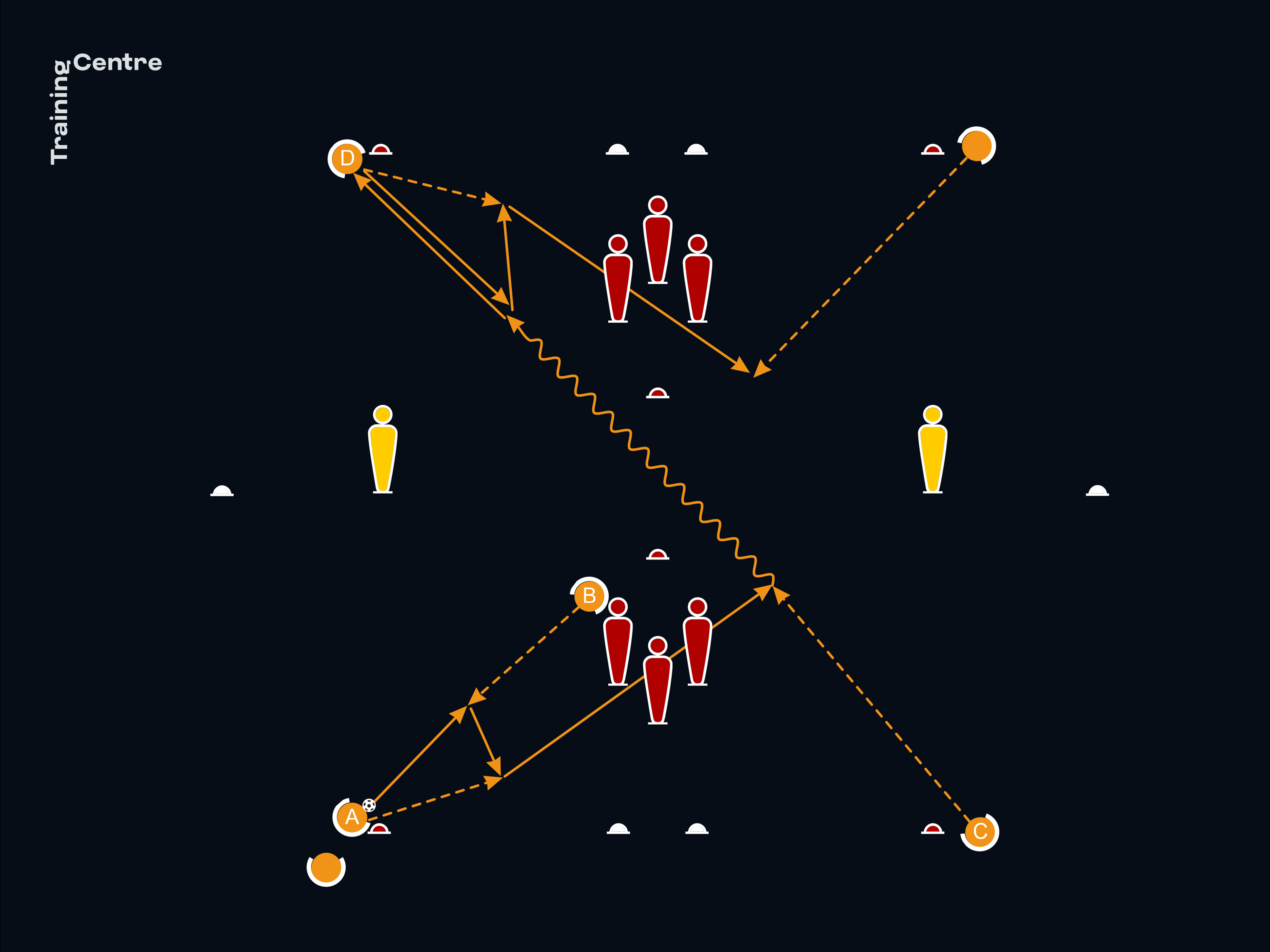
-
A plays a short pass to the incoming B, who plays a short return pass into A’s path.
-
A then plays a first-time pass through the mannequin gate into the path of C.
-
C accelerates from the deep position at the opposite side onto the ball, guiding it through the red cone gate in the middle of the circuit with their first touch and then playing a diagonal pass to D in the opposite corner.
-
D then starts the next sequence.
-
Every player follows their pass so as to ensure rotation.
-
B moves to A.
-
A moves to C.
-
C moves to D.
-
Place the emphasis on the quality of C’s first touch into their own path after receiving the ball while on a cross-field run, which should set an accelerating tempo and tee them up to sweep a diagonal, curved, forward pass into the receiving player’s momentum.
-
Players should play with their heads up and scan the area they are receiving the pass from and the intended destination of their own pass.
-
This drill encourages technical balance as it requires players to use their left and right feet in equal measure.
-
To reinforce good footballing habits, when playing the left-to-right diagonal pass through the mannequin gate, A should try to pass with the right foot. The opposite applies for D for the right-to-left diagonal pass.
-
A/D should be on the half-turn forward to receive the diagonal pass, moving the ball clearly away from the feet with the first touch, to then accelerate it before playing the pass to C.
-
To reinforce good footballing habits, before receiving the return pass from B/C, A/D should have a quick scan across the player out wide (their target for the next pass).
-
When playing the left to right diagonal pass between the mannequin gate, A should try to move the ball infield on the first touch to play a right-footed pass to C. The opposite applies for the right-to-left diagonal pass (a left-footed pass).
-
C should make the run in behind from the deep position in line with A, while also scanning across to A, to coordinate with A and thus time the run to meet the pass.





















